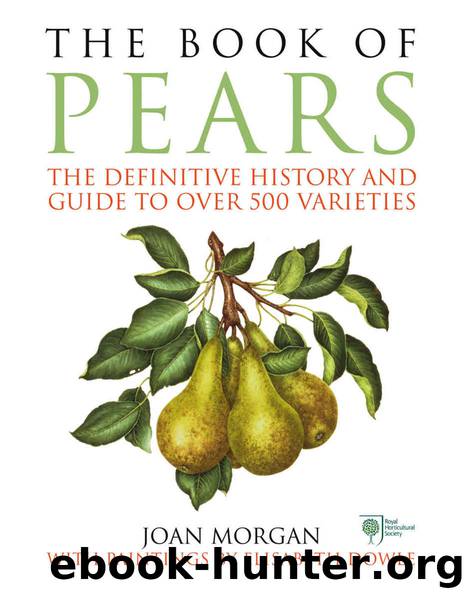The Book of Pears: The Definitive History and Guide to over 500 varieties by Joan Morgan

Author:Joan Morgan [Morgan, Joan]
Language: eng
Format: epub
ISBN: 9781473528338
Publisher: Ebury Publishing
Published: 2015-10-15T00:00:00+00:00
Cascade M D
US: raised early 1940s by F.C. Reimer at Southern Oregon Exp. St., Medford. Max Red Bartlett, Doyenné du Comice cross. Selected 1975. Introduced 1988.
Flushed in deep rose-red. Melting to buttery, juicy, pale cream flesh; sugary with plenty of balancing lemony acidity; rich, perfumed; not quite as luscious as Comice, more acidity; tender skin. Raised for holiday markets in US, harvesting after Bartlett/Williams’.
Fruit: Size: med./large (69–83mm high x 68–79 wide). Shape: pyriform; eye-end: rounded ribs, may be bossed. Colour: deep red flush almost covering surface over light green/yellow background; some fine russet; light russet lenticels. Eye: closed/part-open; sepals small, free, converging. Basin: qt. deep, broad; circles of fine russet like Comice. Stalk: med./qt. long; med. thick. Cavity: qt. pronounced.
F* late, (est. F30); red-tinged flowers and young foliage. T2; uprt.; report. prone scab, mildew. C light/irregular; gd in US. P e/mSept. S Sept. – eOct.
C/Katherine not in NFC
UK probably: ancient variety; recorded 1629 by Parkinson.
Famed for its beautiful colour, it was believed introduced in the time of Henry VIII and named after one of his queens. Its heavy crops of small fruit were still valued even in C19th, as the tree was so reliable: it was said that with crops of other pears you could ‘scarcely pay the rent’, but with the ‘Katherine you could buy the land’. It ripened in August at a time ‘when fruiterers were asking for pears and never mentioning quality’ – selling in the street for six a penny in 1870s.1 Catherine pears were still sent to market at the turn of the century, yet it is not mentioned by Bunyard and never accessed into the Collection.2
Description from Hogg: Size: small. Shape: pyriform. Colour: clear yellow, smooth skin with blush of red and darker red streaks; numerous russet lenticels. Eye: small, open. Basin: v. shallow. Stalk: short, inserted erect. Cavity: absent. Flesh: firm, fine grained, very juicy, sweet; rapidly becomes mealy. Season: Aug. (1. JH, 1874, v. 26, ns, p. 163. 2. GC, 1905, v. 38, p. 252.)
Catillac L C
Syns: Cadillac, Pound Pear
France: generally believed arose near village of Cadillac, Gironde, Aquitaine, south-west France. Recorded 1665 as Cadillac by Bonnefons; UK by 1696 when listed by Brompton Park Nursery, London; US by Downing (1869). Widely distributed.
Large, bulbous-shaped pear. Very firm, tough greenish-white flesh, it has a coarse astringent quality, yet with some sweetness. When cooked, slices soften and develop a delicate flavour, giving a pink tinge to the poaching liquid. In UK, regarded as the foremost baking pear by C19th, planted in country house collections and appearing in London markets; still produced for UK markets in 1920s–30s. Also imported from France. Long grown northern Europe; said to be much appreciated simply cooked with wine to serve as compote; also used for making perry. Very striking in blossom; formerly recommended as ornamental tree. Now rarely planted but many old trees remain all over Britain.
Fruit: Size: large (73–102mm high x 79–93mm wide). Shape: v. short, rounded pyriform mainly, or round-conical; eye-end – rounded ribs, mod./strongly bossed. Colour: green turning greenish-yellow/pale yellow, with slt.
Download
This site does not store any files on its server. We only index and link to content provided by other sites. Please contact the content providers to delete copyright contents if any and email us, we'll remove relevant links or contents immediately.
Periodization Training for Sports by Tudor Bompa(7323)
The MacArthur Bible Commentary by John MacArthur(4231)
The Body: A Guide for Occupants by Bill Bryson(3789)
The Sports Rules Book by Human Kinetics(3581)
What It Really Takes to Get Into Ivy League and Other Highly Selective Colleges by Hughes Chuck(3217)
Marijuana Grower's Handbook by Ed Rosenthal(3114)
The Sprouting Book by Ann Wigmore(3049)
Salt, Fat, Acid, Heat: Mastering the Elements of Good Cooking by Nosrat Samin(2653)
The Martian by Andy Weir(2604)
Classic by Mary Berry(2499)
The Bread Bible by Rose Levy Beranbaum(2467)
Harry Potter 4 - Harry Potter and The Goblet of Fire by J.K.Rowling(2413)
The Marketing Plan Handbook: Develop Big-Picture Marketing Plans for Pennies on the Dollar by Robert W. Bly(2408)
Sapiens and Homo Deus by Yuval Noah Harari(2406)
Martha Stewart's Baking Handbook by Martha Stewart(2328)
50 Economics Classics by Tom Butler-Bowdon(2063)
Screenplay: The Foundations of Screenwriting by Syd Field(2052)
The Cambridge Grammar Of The English Language by Rodney Huddleston Geoffrey K. Pullum(2043)
The Plant Paradox by Dr. Steven R. Gundry M.D(2035)
